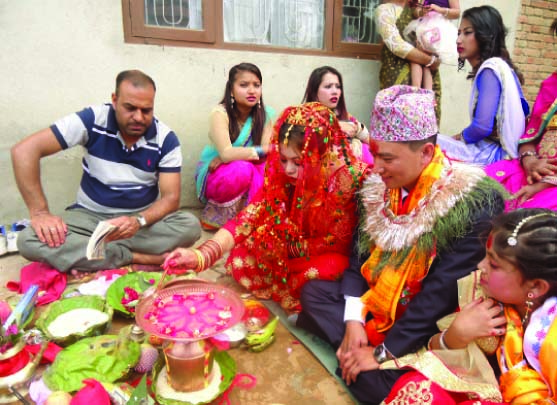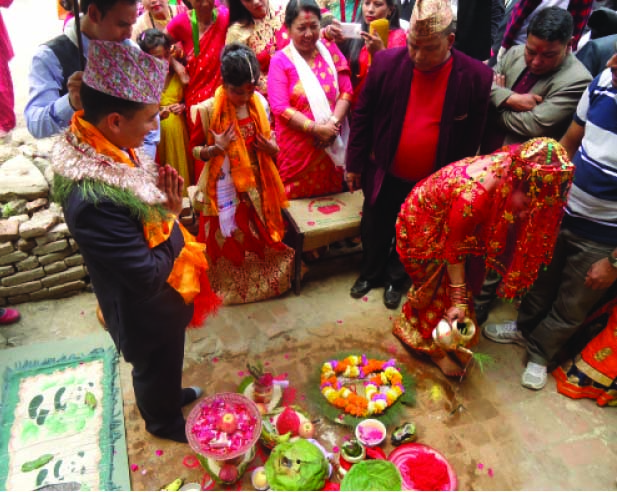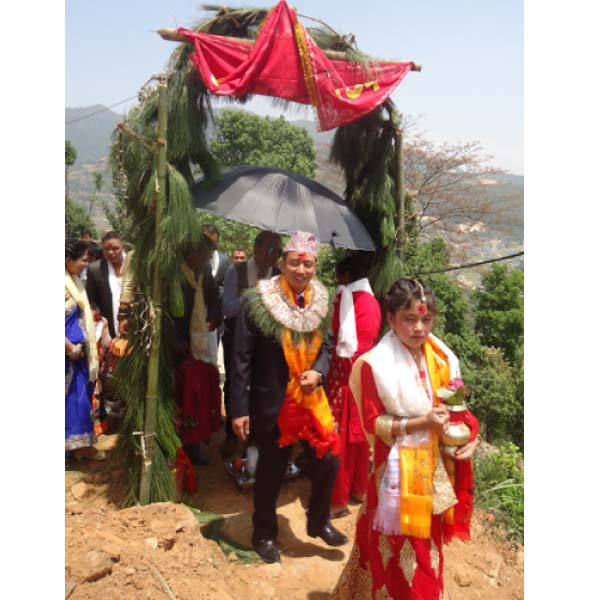
I have finished my Buddhist studies with wise senior Buddhist nuns in a nunnery on top of a hill. Time to take the final exams – attend a Nepali wedding!
A word of caution: Do not take the same curriculum –this ‘exam’ only happens once in a blue moon! It just so happen that the son of the nunnery’s cooks, a charming, 28-year old lad, was tying the knot.
The cooks, Ghale Apa and Ghale Ama (Ghale is the clan/surname), have been serving in the nunnery’s kitchen for 25 years. Many of the senior nuns literally saw Santosh, the groom, grow up from infancy.
I teased Santosh at his wedding how ‘love can be unpredictable’. A few months back, Santosh’s elder sister got married, and I asked when his turn would be. He said not in three years, since his girlfriend Alisha, a newly graduated 22-year old damsel, first wanted to find stable work before settling down.
Five months after that ‘official’ statement, he went with his parents to Alisha’s family home one Friday morning and asked for her hand in marriage.
A month and three weeks after the proposal, the wedding took place. From three years to six months! Nepali culture in general, it seems, is arbitrary when it comes to schedule and time.
The wedding was held on a sunny Saturday: Nepal’s weekend is Friday-Saturday, with Sunday as the start of the work week. The wedding was a blend of largely Nepali culture and Hindu religion.
Though lacking in experience, I attempted to distinguish between its many significant parts.
Graha Shanti, the groom’s ceremony, was a spectacle to behold. It started around 11 a.m., outside Santosh’s
newly built home, a stone’s throw away from the nunnery.

After some mantras chanted by the Pundit (Nepali for officiator), the groom, clad in a Western suit, tie and Dhaka topi (traditional Nepali man’s hat), stood on one side of a table.
His parents stood across from him and anointed his forehead with tika (red uncooked rice). On the table were wedding paraphernalia – fried fish, colorful flowers, candles, incense, a glass of yoghurt and many others.
The Pundit, the village’s head, shouted out the procedures while directing the different ‘actors’ to do their parts. He caught my attention with his maroon velvet suit. Chic!
As the different aunts and uncles took turns putting tika on Santosh, the members of the crowd started getting their tikas as well.
“To identify the members of the groom’s party,” Ani (Tibetan for nun) Pema said.
Led by the groom, the party walked through a grass archway with a tarpaulin wishing Suvakamana (best wishes in Nepali).
I noticed the nunnery’s foreman, Arjun, followed closely behind carrying a red luggage, the repairman Badang with five gallons of local wine, and other men carrying different ‘home essentials.’ All these symbolize bidding the groom a prosperous, new life.
The groom and his father headed to the flower-studded wedding car, while the guests rode behind in a bus. It was time to head to Alisha’s home.
Outside Alisha’s home, on the pavement, a more elaborate and colorful preparation was readied. I noticed that it is Nepal’s custom to be close to the ground. But nobody knows the reason behind such a practice anymore.
Syawambar – the bride’s part
Finally, the bride appeared. Dressed in an enchanting red and gold sari, she first took a groupie with her two bridesmaids. Sitting on special cushions, they began the main wedding rituals.
The more demanding ritual focused around a mandala-like plate.
Led by a more experienced Pundit, Alisha did most of the tasks, anointing and sprinkling different corners of the plate at specific stages. Incense were lighted or flower petals were thrown in at intervals. The whole proceeding lasted 45 minutes.

Lunch
The lunch was held just outside the house, in a makeshift ballroom, with the newlyweds occupying a royal two-seater sofa. More relatives queued to put tika on the couple’s foreheads and presented gifts.
Numerous young ladies, friends of the couple, were dressed in shimmering saris – purple, cream, black, royal blue, green, red studded with glittering sequins.
I noticed high heels and designer bags – modern touches that complemented the traditional milieu. With shiny long hair and full makeup, they were truly Nepali princesses.
The food was sumptuous. Basmati long-grain rice, sweet-salty prata, chickpea in yellow curry, a medley of vegetables in orange curry, okra and potato in red curry, meat dishes and salad to name just a few. It was topped with sweet yoghurt and jalebi, a sugar-coated, deep-fried dough for dessert.
After lunch, the nuns needed to go back up to the nunnery to conduct the daily afternoon prayers. Ani Pema asked a relative what time the bride would ‘leave the house.’ He replied 6 p.m.
I was confused. ‘Leave the house’ to go where? Then I realized that another party is being prepared later that evening – the groom’s!
I found it interesting that although on paper, they are Hindus, Ghale Apa’s family closely followed the Buddhist tradition.
So the groom’s Hindu wedding ritual was conducted in a Buddhist shrine hall. At 7 p.m., with the couple sitting in front of the hall, the nuns chanted prayers for the longevity of the couple.
Following that, the village head resumed the officiator’s position and guided the couple on the final rituals. First, he gave a short advice that married life can be difficult: he made the two promise the big Buddha statue behind them that they will respect their marriage vows over any problems. Then the couple turned around, folded their hands and made a short prayer.
The groom then laid out a long, white cloth, starting from the ground to the seated bride’s crown. The groom then sprinkled Sindoor powder (a natural vermillion-colored plant dye), from the bottom to the top, anointing her seudoo or hair parting. This signified that Alisha is married. She has to apply this everyday henceforth.
Lastly, the village head fed the two different sorts of food, making sure they bit from each other’s bite. For some food, they shared a spoon. This is their equivalent to our ‘sealed with a kiss’ tradition.
The young nuns shrieked and giggled awkwardly.
A feast followed. It was conducted beside the nunnery grounds, so I assumed it would leave out the excessive drinks and jarring music. All the nuns were invited.
The bride and groom ate separately with the senior nuns inside the nunnery. Everything had come full circle.
I took my leave of the nunnery the next morning. After saying my goodbyes to the nuns, both teachers and friends, Santosh came up and bid me farewell.
Still enchanted by the ‘once-in-a-lifetime’ spectacle of a Nepali wedding, I wanted to ask him a ‘cheeky’ follow-up question – how many children is he planning to have.
Before asking, I remembered my question to him six months ago, at the huge disparity between his ‘theoretical answer’ and reality. I have a feeling that it will be the same response – that love is really unpredictable!